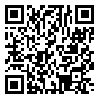Volume 34, Issue 3 (10-2025)
JGUMS 2025, 34(3): 278-293 |
Back to browse issues page
Research code: 952628
Ethics code: IR.GUMS.REC.1397.476
Download citation:
BibTeX | RIS | EndNote | Medlars | ProCite | Reference Manager | RefWorks
Send citation to:



BibTeX | RIS | EndNote | Medlars | ProCite | Reference Manager | RefWorks
Send citation to:
Mohammaddoust S, Tabari-Khomeiran R, Pariad E, Kazemnejad E, Chenot T. Assessment of Nursing Students’ Perception of Patient Safety in Special Care Units: A Study in Guilan Province, North of Iran. JGUMS 2025; 34 (3) :278-293
URL: http://journal.gums.ac.ir/article-1-2719-en.html
URL: http://journal.gums.ac.ir/article-1-2719-en.html
1- Department of Nursing, Kausar Hospital Astana Ashrafieh, Guilan University of Medical Sciences, Rasht, Iran.
2- Department of Nursing, Social Determinants of Health Research Center, School of Shahid Beheshti Nursing and Midwifery, Guilan University of Medical Sciences, Rasht, Iran.
3- Department of Nursing (Medical-Surgical),Instructor,GI Cancer Screening and Prevention Research Center(GCSPRC), School of Shahid Beheshti Nursing and Midwifery, Guilan University of Medical Sciences, Rasht, Iran.
4- Department of Biostatics, Road Trauma Research Center, School of Health, Guilan University of Medical Sciences, Rasht, Iran.
5- Department of Nursing, College of Nursing, Ohio State University, Columbus, Ohio.
2- Department of Nursing, Social Determinants of Health Research Center, School of Shahid Beheshti Nursing and Midwifery, Guilan University of Medical Sciences, Rasht, Iran.
3- Department of Nursing (Medical-Surgical),Instructor,GI Cancer Screening and Prevention Research Center(GCSPRC), School of Shahid Beheshti Nursing and Midwifery, Guilan University of Medical Sciences, Rasht, Iran.
4- Department of Biostatics, Road Trauma Research Center, School of Health, Guilan University of Medical Sciences, Rasht, Iran.
5- Department of Nursing, College of Nursing, Ohio State University, Columbus, Ohio.
Abstract: (828 Views)
Background Maintaining patient safety, regardless of treatment outcome, is one of the fundamental rights of patients.
Objective This study aims to investigate the nursing students’ perception of patient safety in special care units.
Methods In this analytical cross-sectional study, participants were 233 nursing students from the nursing faculties of universities in Guilan Province, north of Iran, who were recruited using a census method. To investigate their perception of patient safety in special care units (ICU, CCU, and dialysis), the health care professionals patient safety assessment curriculum survey (HPPSACS) was used. Data were analyzed using descriptive and inferential statistics, including the Mann-Whitney U test, the Kruskal-Wallis test, Friedman’s test, and Spearman’s correlation test.
Results Most of the students were female (64.4%). The mean age of nurses was 23.47±3.61 years. The majority (68.3%) agreed that the errors of healthcare professionals are unavoidable. In terms of error reporting behaviors, 67% students stated that they had care errors in their clinical practice. Furthermore, 76.9% believed that there was a gap between what they know as best care and what they provide. There was a significant difference in error reporting behaviors based on age (P=0.006), and semester (P=0.001); and university (P=0.001), a significant difference in comfort with skills based on clinical/student work experience (P=0.004), and a significant difference in patient safety perception based on clinical/student work experience (P=0.018). No significant difference in attitudes towards patient safety was observed based on any demographic/educational factor (P>0.05).
Conclusion The nursing students’ perception of patient safety is higher than average, although more than half of them had unacceptable error reporting behaviors, indicating that appropriate educational programs are needed to improve their error reporting behaviors.
Objective This study aims to investigate the nursing students’ perception of patient safety in special care units.
Methods In this analytical cross-sectional study, participants were 233 nursing students from the nursing faculties of universities in Guilan Province, north of Iran, who were recruited using a census method. To investigate their perception of patient safety in special care units (ICU, CCU, and dialysis), the health care professionals patient safety assessment curriculum survey (HPPSACS) was used. Data were analyzed using descriptive and inferential statistics, including the Mann-Whitney U test, the Kruskal-Wallis test, Friedman’s test, and Spearman’s correlation test.
Results Most of the students were female (64.4%). The mean age of nurses was 23.47±3.61 years. The majority (68.3%) agreed that the errors of healthcare professionals are unavoidable. In terms of error reporting behaviors, 67% students stated that they had care errors in their clinical practice. Furthermore, 76.9% believed that there was a gap between what they know as best care and what they provide. There was a significant difference in error reporting behaviors based on age (P=0.006), and semester (P=0.001); and university (P=0.001), a significant difference in comfort with skills based on clinical/student work experience (P=0.004), and a significant difference in patient safety perception based on clinical/student work experience (P=0.018). No significant difference in attitudes towards patient safety was observed based on any demographic/educational factor (P>0.05).
Conclusion The nursing students’ perception of patient safety is higher than average, although more than half of them had unacceptable error reporting behaviors, indicating that appropriate educational programs are needed to improve their error reporting behaviors.
Review Paper: Research |
Subject:
Special
Received: 2024/08/2 | Accepted: 2025/03/8 | Published: 2025/10/2
Received: 2024/08/2 | Accepted: 2025/03/8 | Published: 2025/10/2
| Rights and permissions | |
 |
This work is licensed under a Creative Commons Attribution-NonCommercial 4.0 International License. |









